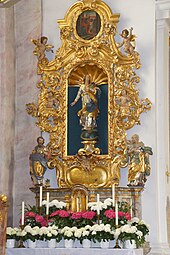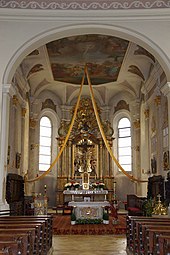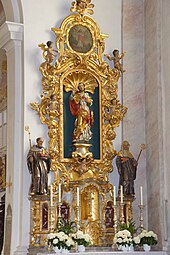St. Johannes (Hemau)
The Roman Catholic Church of St. Johannes (also: St. Johann Baptist ) is an originally Gothic hall church in Hemau in the Upper Palatinate district of Regensburg . It belongs to the parish of St. Johannes Hemau in the Laaber deanery of the diocese of Regensburg .
history
The first church on site was consecrated in 1125 by Bishop Otto von Bamberg . In 1138 the church belonged to Hohenschambach. In the period before 1209 the parish was incorporated into the convent . According to an inscription on a pillar, the choir was added in 1477, the Gothic vault was replaced by a mirrored ceiling in 1705. In 1715 Abbot Otto vonprüfunging laid the foundation stone for a new building, which was built by master bricklayer Johann Ulrich Beystadler and master carpenter Georg Eichenseher from Hemau and consecrated in 1721. The late Gothic tower was demolished in 1724/1725 and rebuilt in 1729, presumably by the prince-elector masons Michael and Josef Wolf from Stadtamhof. The choir was restored in 1755, some of the windows were changed. In the years 1852 and 1879, further restorations were carried out in which the ceiling painting was renewed. During a restoration in 1958, the altars from the side chapels were moved to the choir wall and the glass paintings in the choir windows were removed.
architecture
The broad, recessed choir with five-eighth end and buttresses dates from the late Gothic period . The baroque nave is a hall typical of the region, which is opened in the second axis from the east in flat-arched chapel niches with shell vaults. The walls are structured with pilasters , and a two-story gallery is built into the west. An oratorio is built into the choir in the south above the baroque sacristy . The economical stucco was created in the construction period around 1720. The painting on the sides of the choir from 1755, ascribed to Otto Gebhard , was plastered in the 19th century and exposed in 1989/1990.
Furnishing
The altar from the years 1757–1763 by Franz Anton Neu fromprüfunging was taken over from the abandoned village of Kittensee in 1951. Instead of the altar sheet , a crucifixion group from Nagel in the Fichtelgebirge was subsequently installed behind the frame . On the choir wall are two foliage altars typical of the Upper Palatinate from 1721 and 1723, which are attributed to Johann Michael Schaller from Velburg. On the left is the former Sebastian altar, on the right the former Joseph altar, both of which are framed with broad acanthus tendrils, in which putti are integrated. The main characters of the two altars were later moved to the side chapel altars.
A picture of the Black Madonna is attached to the northern wall of the choir , which is set in a finely carved Rococo frame. Several important late Gothic wooden reliefs from around 1500 have been affected by a newer version. They probably come from a winged altar, represent Johann Baptist and Johannes Evangelista and are stylistically close to the early work of Veit Stoss . Characteristic is the wide landscape depiction of John on Patmos with expressive drapery. The spatial representation and details of the contemporary costume and interior are similar to the representation on two relief panels from Vohburg with St. Andrew, which are now kept in the Diocesan Museum of Regensburg . The Way of the Cross contains remarkable images from around 1700.
Of the grave monuments, the monumental epitaph for the Hemau nurse Sebastian von Parsberg zu Lupburg († 1525) on the north outer wall with a representation of the deceased in full armor, framed by a Renaissance aedicule and the coat of arms of those of Parsberg and Murach in the spandrels of the Mention archivolt . On the south side is the epitaph for the Hemauer nurse Wilhelm Berlin († 1572) with a representation of the deceased in full figure with armor, which is attributed to the Regensburg sculptor Hans Pötzlinger from around 1569/1570. One of the three bells with Romanesque inscriptions may still come from the first church building in 1125.
literature
- Georg Dehio: Handbook of the German art monuments. Bavaria V: Regensburg and the Upper Palatinate. Deutscher Kunstverlag, Munich, Berlin 2008, ISBN 978-3-422-03118-0 , pp. 221–222.
Web links
Individual evidence
- ↑ a b c website of the parish of St. Johannes Hemau. Retrieved May 9, 2019 .
Coordinates: 49 ° 3 ′ 6.9 ″ N , 11 ° 46 ′ 52.8 ″ E




